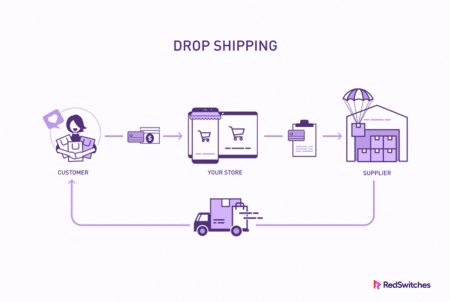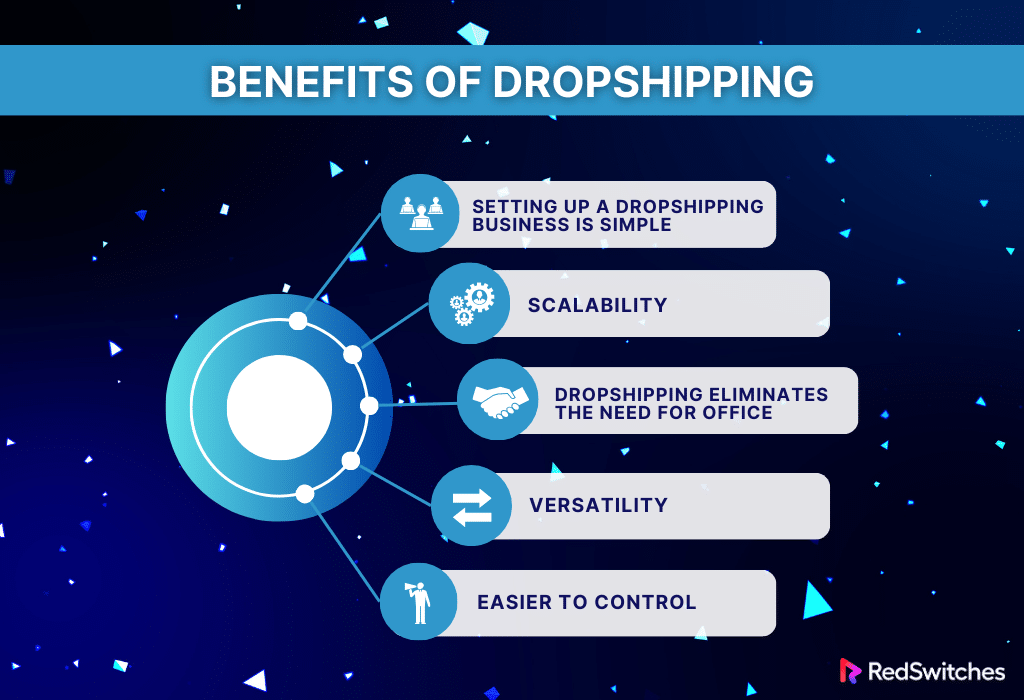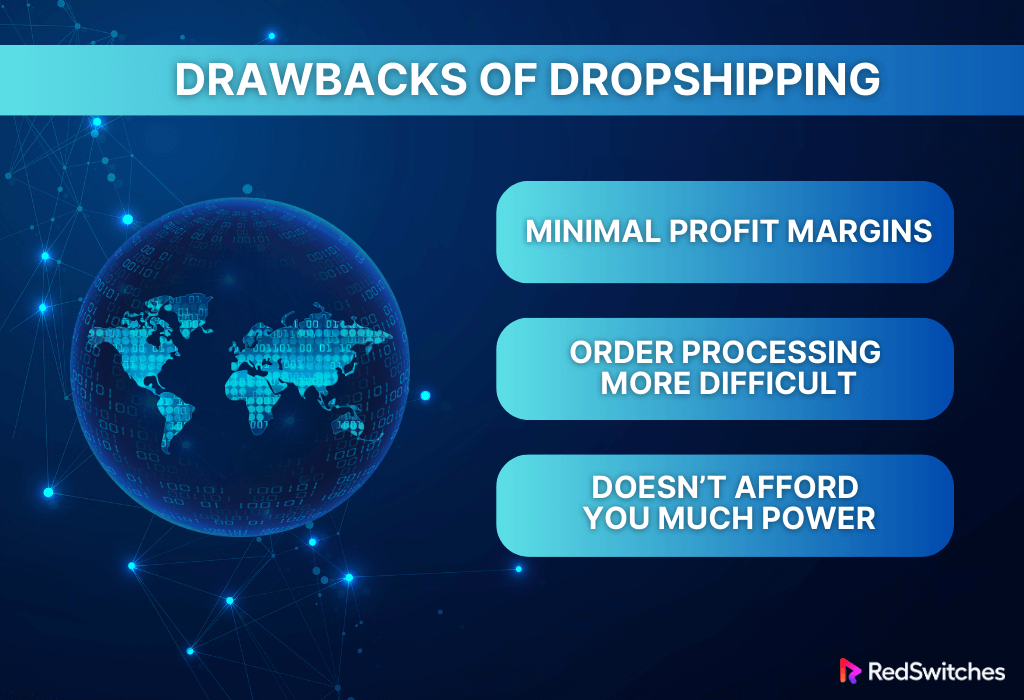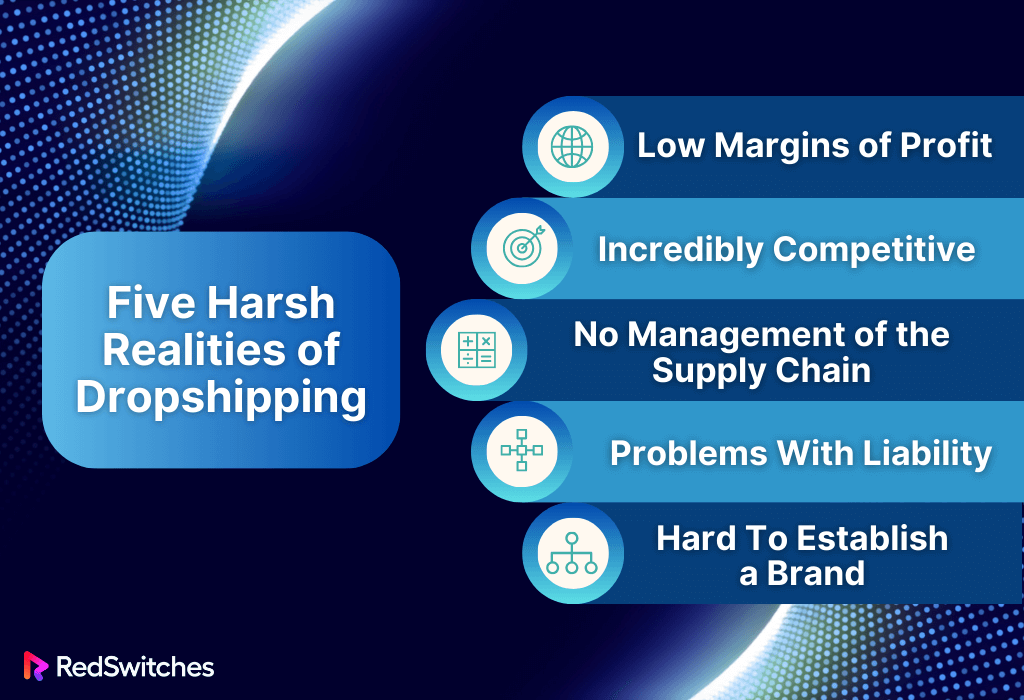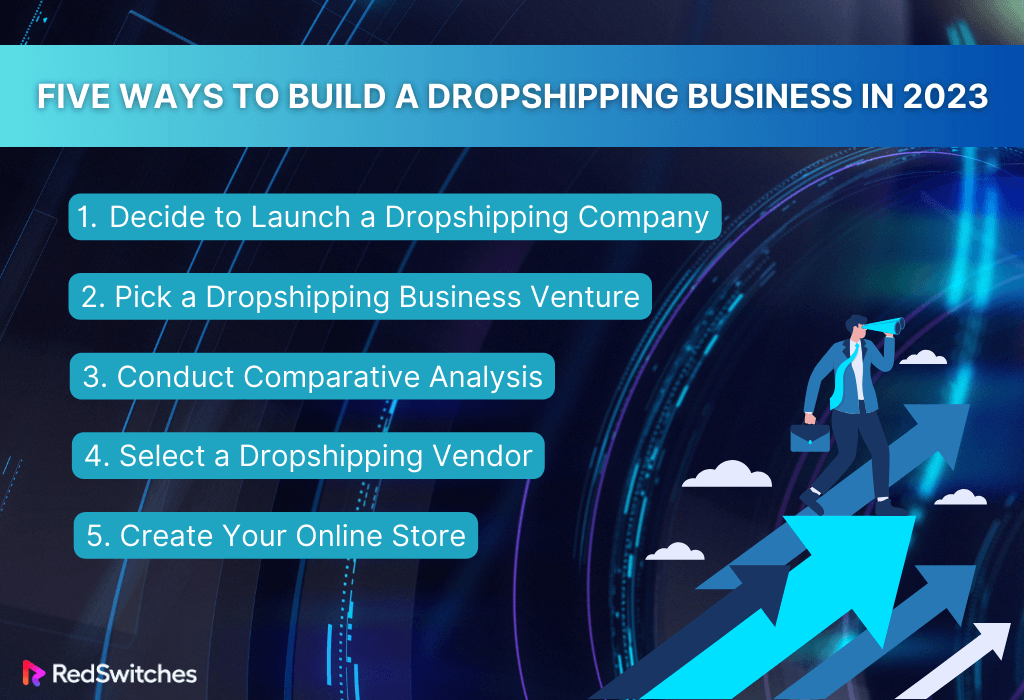Assume you’ve decided to create an online store that sells a variety of things to customers all around the world. Dropshipping is a more imaginative approach than keeping products in a warehouse or dealing with the headaches of packaging and shipping. In this business model, you partner with suppliers who handle inventory and fulfillment.
Products are only purchased when you make a sale and distributed straight to your clients. This dropshipping primer delves into the intricacies of this creative and low-risk e-commerce strategy, in which the world becomes your storefront, and success is determined by your ability to connect customers with products effortlessly.
In this blog article, we will explore what is dropshipping, Its Pros and Cons, and the importance of hosting in dropshipping.
Table Of Contents
- Understanding Dropshipping
- Pros and Cons of Dropshipping
- Is Dropshipping Really Profitable?
- The Right Approaches To Dropshipping
- Five Harsh Realities of Dropshipping
- Choosing the Best Dropshipping Suppliers
- The Importance of Hosting in Dropshipping
- Five Ways To Build a Dropshipping Business in 2023
- Conclusion
- FAQs
Understanding Dropshipping
In our first section, we will understand the definition: What is dropshipping? And also the working of dropshipping.
What Is Dropshipping
Dropshipping is typically employed by e-commerce businesses that do not stock their inventory. It is a fulfillment method in which a retailer receives orders for products featured on the storefront and forwards them to the supplier for fulfillment.
This is a win-win situation for retailers and suppliers because it allows them to focus solely on the business processes in which they excel—retailers can develop customer connections. In contrast, suppliers can maintain inventory and distribute products.
Dropshipping is a method of selling products utilized by wholesalers and manufacturers worldwide.
How Dropshipping Works
Dropshipping is comprised of four simple steps:
- The customer purchases from the retailer.
- The order is first processed by the retailer and forwarded to the supplier.
- The order is filled in the supplier’s warehouse.
- The order is shipped to the customer by the supplier.
Everything is fine if the buyer is satisfied with the product they receive. The merchant should employ customer relationship management (CRM) software to cultivate relationships and encourage future orders.
When a customer is dissatisfied with a product and wants to return it, issues occur. We’ll get to that later when we talk about the constraints of dropshipping.
Key Players in the Dropshipping Model
Let’s break down some important participants and their roles, beginning with the seller of record—your company.
Seller of Record
You are the first step in the dropshipping process. As the seller of record (SoR), you are the person who is responsible for selling the goods to the end user. You determine the price, record the transaction as revenue, and are liable for the sales tax on a specific sale.
Even if the things are stocked and shipped by a third party, you are the seller of record, as you own the products before they are shipped to the client.
Using a dropshipping service is generally permitted for Amazon sellers, as long as you are the seller of record and identify yourself as such.
Manufacturers
Manufacturers create goods for distributors and retailers. You can buy things from manufacturers, but the large purchase quantities they may require can be a barrier to launching or developing your business. Some manufacturers provide dropshipping services.
Wholesalers
Wholesalers buy from manufacturers and sell them to retailers in a typical product supply chain at a modest markup. They act as intermediaries; they usually do not sell to end users but may supply dropshipping services to retailers.
Determine whether dropshipping suppliers would be a good fit for you depending on your business model and fulfillment needs, among other things.
Pros and Cons of Dropshipping
Now, let’s focus on the merits and disadvantages of Dropshipping in detail.
Benefits of Dropshipping
Setting up a Dropshipping Business Is Simple
Dropshipping does not need any prior company expertise. If you spend some time learning the fundamentals, you can start a business easily and learn the rest as you go.
Start-up costs for a dropshipping business are inexpensive compared to other retail business models. For example, you don’t need a warehouse to keep your products or a workforce to assist you. You also don’t have to bother about inventory or shipping. It’s surprisingly hands-off once you get started.
Scalability
Your business model doesn’t have to change much when you go up. As you expand, you’ll have to make more sales and marketing attempts, but your day-to-day operations will remain mostly the same, save from processing more orders.
One benefit of dropshipping is that infrastructure expenses do not soar as you scale. Therefore, you have more funds for your company’s marketing efforts. The more you focus on marketing your company and providing excellent customer service, the better off you will be.
Dropshipping Eliminates the Need for Office
You may run a full business from your laptop without making any significant financial commitments. Your most considerable outlay will be advertising, which you can increase as your store’s popularity grows. Your costs will be quite cheap, especially compared to usual business expenses, even as your organization expands.
Versatility
One of its main advantages is this. You get to make the rules and be your boss. It’s undoubtedly one of the most adaptable professions that anyone may choose from.
Easier To Control
You can manage everything with minimum fuss because it doesn’t require you to make many commitments, such as hiring staff or renting warehouse space. Most of the time, all that’s left for you to do after finding suppliers and setting everything up is to manage your online storefront.
Drawbacks of Dropshipping
Everything seemed easy when we discussed the benefits of the dropshipping model. However, there are some critical disadvantages of this model as well. Let’s discuss.
Minimal Profit Margins
Dropshipping has some drawbacks, including that you should initially anticipate poor margins. It’s still possible to make money, but you should be aware that the product margin may be low in some areas.
This challenge is tough if you dropship in a highly competitive market. When competing for clients ‘ attention, generating the revenue you want can be tough.
However, you’re much more likely to achieve wider margins if you pick the proper niche and focus on the right audience. You’ll also make more money in niches with less competition, although eventually, sales may start to level out.
Dropshipping Might Make Order Processing More Difficult
Dropshipping appears to be simple: The customer first places the order, you process it, and your supplier ships it. And the majority of the time, it is accessible.
However, you can encounter specific issues when sourcing goods from multiple providers. It may be impossible for all of your suppliers to use a similar delivery method, which causes issues for both you and your clients.
The delivery cost may be too much depending on your shipping setup, especially when mailing multiple things.
Dropshipping Doesn’t Afford You Much Power
Dropshipping has a few drawbacks, including not having complete control over product stocking, order fulfillment, and shipping.
You must rely on your vendors to complete tasks accurately and efficiently. Some business owners may find this lack of control unsettling, although it usually doesn’t cause issues.
Is Dropshipping Really Profitable?
A critical question that arises in the minds of the owners of big firms is whether this model is profitable or whether it is like a no-profit, no-loss situation. Let’s explore.
As a Side Business
The main concern is that your employer will forbid you from engaging in a side business, although, believe it or not, many businesses are okay with it. Asking about your employer’s position on side enterprises and reviewing any non-compete agreements you’ve signed will help you confirm that you’re clear.
Additionally, you need to make sure there are no conflicts of interest. But if everything looks good, you can move forward.
E-Commerce as a Full-Time Business
Flexibility is one of the advantages of dropshipping. Your company can be as big or as small as you would like. Although dropshipping is sometimes done as a side business, it may also be rewarding. You have the option to work as a dropshipping retailer full-time.
Dropshipping can be done full-time if you’ve attracted enough clients and generated enough sales. The best part is that you may move forward with this at your own pace.
Of course, this will require more labor, but the result is well worth the effort. You won’t have to worry about inconsistent income after you learn how to dropship successfully.
The Right Approaches To Dropshipping
The sideshow that is dropshipping is superior to the main event. While its flaws make it difficult to sustain a firm independently, it provides enough advantages to aid e-commerce companies in significantly enhancing their operations.
Take into account these four strategies to use dropshipping successfully:
Suitable Market Research
Dropshipping functions best when used as a tool, not as a goal in and of itself.
To reduce the risk of experimenting with new products and to do market research, employ dropshipping.
Instead of cluttering your warehouse with an unexpected product and increasing your inventory expenditures, try it out for a trial period using dropshipping.
In addition to learning if it sells or not, you’ll have a better idea of how much it sells for, providing you with a more precise estimate of how much to purchase as your initial stock.
Safeguards Against Overselling
E-commerce brands with experience are aware that market changes aren’t always foreseeable. Having a dropshipping provider as a backup saves you money without losing those sales instead of increasing inventory expenses by overstocking to reach improbable maximums.
Especially for seasonal overflow, this is beneficial.
It’s a fantastic defense against the risks that all sellers must deal with.
Strategic Shipping Management
Shipping issues are a regrettable side effect of corporate expansion. Your distance from your warehouse or fulfillment centers will increase the amount of shipping fees and expenditures you pay.
Dropshipping may be the ideal response for some complex markets outside your lucrative ones.
Perhaps the expense of transporting that far away or the cost of storage makes establishing a new shipping center unjustifiable.
Perhaps there are taxes or other costs involved, such as when shipping outside of the state or nation. Relying on dropshipping for these specific markets could make the difference between staying in the black and going under.
Five Harsh Realities of Dropshipping
After an online purchase, the dropshipping company sends the ordered item directly to the consumer. It allows big and small businesses to source goods, earn extra cash, and free up storage space.
Of course, this is easier said than done, so before you invest all of your cash in a dropshipping business, consider the following reasons why it can be challenging:
Low Margins of Profit
The expense is cheap because you don’t have to handle or keep your product, but the returns are also modest.
Less money is invested, but less money is returned. Because most of the money goes to the supplier, you must conduct a lot of business to break even, let alone earn a profit.
These meager margins hardly cover your fees and overhead for marketing and promotion, website upkeep, search engine optimization (SEO), order management, and staffing office hours.
Incredibly Competitive
There will always be overconfident business owners who just consider the “low overhead” aspect and dismiss the blatant proof presented above.
Due to the minimal entry requirements for dropshipping businesses, there are a lot of solid rivalries, with the most well-liked marketplaces suffering more than others.
Generally, a corporation can lower its markups to offer the lowest pricing the larger it becomes.
The likelihood of not having an exclusive agreement with your suppliers worsens the situation.
No Management of the Supply Chain
In regular e-commerce, you can take care of issues with product quality, order fulfillment time, or return policies on your own.
Store owners who use dropshipping are mainly at the whim of the supplier, but you are still responsible for communicating with your clients.
Dropshippers are virtually stuck; they can only wait for the supplier to fix the issues while reassuring the consumer about a situation beyond their control.
Problems With Liability
Even though this isn’t a typical issue for drop shippers, it’s essential to address. You may not always be able to identify the origin of the goods because some providers are not as reliable as they claim to be.
Even more misleading are providers who, more often than not, illegally use a trademarked logo or the intellectual property of another business.
Hard To Establish a Brand
Dropshippers need to be aware that the credit for their work belongs to someone else, just as ghostwriters or hidden songwriters.
If the goods you’re offering are truly exceptional, your customers will completely disregard the buying experience and concentrate only on the brand of the product.
After all, the box’s branding is not yours.
Choosing the Best Dropshipping Suppliers
When choosing the best dropshipping suppliers, we must try to find answers to some particular questions.
Here is a quick reference list of inquiries to do before agreeing to conduct business with anyone:
- How do they manage product returns or damage?
- How long does it take them to complete an order from sale to delivery?
- How is the company’s customer service? (Feel free to experiment with this.)
- Do they insure orders?
- Do they protect from fraud?
The Challenge of Choosing Suppliers
Creating a trustworthy network of suppliers who reflect the brand to the same high standards as the brand itself may be the most challenging obstacle in dropshipping. If you’re interested, there are a few ways to screen potential drop shippers. Reviews and lists of dropship vendors may be found everywhere.
Fees, order minimums, industry-specific knowledge (shipping telecom technology is very different from shipping food), support personnel, efficiency, reaction to email orders and availability of data feeds are all things you should consider when searching for a supplier.
The Importance of Hosting in Dropshipping
After discussing our focus question: What is dropshipping, and what are the challenges in choosing the suppliers in dropshipping, it is vital to know what to look for hosting in dropshipping. Let’s discuss the points in brief.
High Performance
Online business operators now confront even more significant problems due to e-commerce’s explosive expansion. One of them is guaranteeing excellent website performance regardless of how many customers are at any given time exploring the product catalog or placing orders. Low conversion rates and abandoned carts are inevitably caused by slow page loads or the inability to find relevant search results.
Unlimited Bandwidth and Storage
When selecting the finest hosting for e-commerce, the quantity of resources allotted to your online company is crucial. The most crucial figures to check for are listed below:
Storage. Your storage determines how much disc space your website can use.
PHP employees. The amount of traffic your website can take without noticeably degrading performance depends on how many PHP workers are handling web requests.
Bandwidth. How much data you may transport to website users across the network depends on the supplied bandwidth. Unlimited bandwidth guarantees that you won’t be overcharged even in the event of a significant traffic uptick.
Integrated Security Measures
Since online shops and marketplaces host, process, and receive payments for sensitive client information, security is a top concern in the e-commerce sector.
You must install various server and website solutions to safeguard your customers’ data from numerous security risks and ensure a secure shopping experience.
Web hosting for e-commerce should include an extended range of integrated security measures, such as PCI compliance and SSL certificates.
Five Ways To Build a Dropshipping Business in 2023
This blog section will provide five ways to build a dropshipping business in 2023.
Decide to Launch a Dropshipping Company
Dropshipping requires a big dedication and a long-term outlook, just like any other type of business. You will let yourself down if you expect to make six figures in six weeks of part-time work.
You’ll be much less likely to get discouraged and give up if you approach your firm with realistic expectations regarding the investment needed and your profit potential.
Pick a Dropshipping Business Venture
The appropriate market research must be carried out as the second step in learning how to launch a dropshipping firm.
You want to research a niche you’re interested in and base your judgments on how successful it can be, just like if you were putting up a retail store and researching the various locations, rivals, and trends.
Conduct Comparative Analysis
Now that you know what you will sell at your store, you must research your rivals and learn how they operate. You may learn a lot from your rivals’ successes to improve your dropshipping business’s marketing strategy.
Limit your study to roughly four other dropshipping businesses, including one or two major companies like Walmart, eBay, or Amazon, if your market has many competitors (which is beneficial for dropshipping). You can plan your future steps and stay focused with its assistance.
Select a Dropshipping Vendor
Selecting a supplier is a crucial first step in starting a successful dropshipping business. Without trustworthy suppliers, a drop shipping company would have nothing to ship to clients and would thus go out of business.
Create Your Online Store
An e-commerce platform is the next thing you need to start a dropshipping business. You’ll send traffic here, sell things here, and handle payments here.
So we have any important so that will be done.
Conclusion
In conclusion, In this blog article, we tried to answer the most frequently asked question: What is dropshipping?
Dropshipping provides business owners with a dynamic and affordable way to enter e-commerce. We’ve looked at the basics of dropshipping, its workings, and its advantages, like low initial expenses and minimum inventory management.
Recognizing the negative aspects, such as the diminished ability to influence product quality and delivery schedules, is essential. Since the success of your dropshipping business depends on the performance of your suppliers, choosing trustworthy ones is a crucial difficulty in this endeavor.
Furthermore, it is essential to recognize hosting’s importance in giving your clients a seamless online retail experience.
Remember the significance of dependable hosting services as you begin your dropshipping journey because they might significantly impact your website’s functionality and consumer satisfaction.
Consider RedSwitches if you’re seeking a reputable hosting option, because we offer the best dedicated server pricing and deliver instant dedicated servers, usually on the same day the order gets approved. Whether you need a dedicated server, a traffic-friendly 10Gbps dedicated server, or a powerful bare metal server, we are your trusted hosting partner.
FAQS
Q-1) What is dropshipping?
A retail fulfillment technique called dropshipping involves a store not maintaining an inventory of its goods. Instead, a store will buy a product from a third party and ship it directly to the buyer when it sells it.
Q-2) Is dropshipping appropriate for novices?
Due to its minimal entrance hurdles, dropshipping can be an excellent choice for newcomers. The key to success in dropshipping is to approach it with a sound strategy and reasonable expectations because it calls for extensive research, efficient marketing, and a dedication to customer happiness.
Q-3) How does dropshipping work?
Dropshipping works by following these steps: 1. The online store lists products from suppliers on its website. 2. Customers place orders for the products. 3. The store owner forwards the order and the customer’s details to the supplier. 4. The supplier packages and ships the products directly to the customer. 5. The store owner pays the supplier for the products sold.
Q-4) What are the benefits of dropshipping?
Some of the benefits of dropshipping include: – Low startup costs: Dropshipping eliminates the need for inventory, reducing upfront costs. – Easy to start: Setting up a dropshipping business is relatively simple and does not require a physical store. – Wide product selection: With dropshipping, you can choose from a vast range of products to sell. – Location flexibility: As long as you have an internet connection, you can run your dropshipping business anywhere. – Reduced risk: Since you don’t need to invest in inventory upfront, the risk of unsold products is minimized.
Q-4) Is dropshipping right for my business?
Dropshipping can be a suitable business model for various types of businesses, including those with limited startup capital, those looking for location flexibility, and those focused on selling niche or specialized products. However, it’s essential to analyze your specific business needs and assess whether dropshipping aligns with your goals and target market.
Q-5) How do I start a dropshipping business?
To start a dropshipping business, follow these steps: 1. Choose a niche or product category to specialize in. 2. Research and find reliable dropshipping suppliers within your chosen niche. 3. Set up an ecommerce platform or website to showcase your products. 4. List and market the products from your suppliers on your website. 5. Drive traffic to your website and promote your products through various marketing channels. 6. Process orders and coordinate shipping with your suppliers. 7. Continuously analyze and optimize your business operations to enhance profitability and customer satisfaction.
Q-6) What are the alternatives to dropshipping?
Some alternatives to dropshipping include: – Wholesale: Buying products in bulk at a discounted price and reselling them individually. – Print-on-demand: Creating and selling custom-designed products, with the manufacturer handling production and shipping. – Self-manufacturing: Producing your products in-house and selling them directly to customers. – Affiliate marketing: Promoting other companies’ products and earning a commission for each sale. – Retail arbitrage: Finding products at a low price and reselling them for a profit.
Q-7) What are the disadvantages of dropshipping?
While dropshipping has many benefits, it also has some drawbacks, including: – Lower profit margins: Since you’re purchasing products at a higher price than wholesale, your profit margins may be smaller. – Less control over shipping times and packaging: As the supplier handles shipping, you have limited control over delivery times and packaging quality. – Inventory and supplier management: Coordinating with multiple suppliers and managing inventory levels can be time-consuming and challenging. – Increased competition: Dropshipping has grown in popularity, increasing competition in many niches.
Q-8) How to find dropshipping suppliers?
There are several ways to find dropshipping suppliers: – Online directories: Platforms like Oberlo, SaleHoo, and AliExpress provide lists of suppliers in different categories. – Direct contact: Reach out to manufacturers or wholesalers directly and inquire about dropshipping partnerships. – Trade shows and exhibitions: Attend industry events to network with potential suppliers and establish relationships. – Online research: Use search engines and social media platforms to discover potential suppliers within your niche.
Q-9) What is the dropshipping business model?
The dropshipping business model is a retail fulfillment method where a store doesn’t keep the products it sells in stock. Instead, when a store sells a product, it purchases the item from a third party and has it shipped directly to the customer. The store owner earns a profit on the difference between retail and wholesale prices.
Q-10) How does drop shipping differ from a traditional retail business?
Dropshipping differs from a traditional retail business in several ways: – Inventory management: With dropshipping, you don’t need to purchase or manage inventory. – Fulfillment: Dropshipping relies on suppliers to package and ship products directly to customers. – Overhead costs: Dropshipping typically has lower overhead costs than traditional retail businesses. – Scalability: Dropshipping allows for easier scaling since you don’t need to invest in physical infrastructure or inventory upfront.
Q-11) Can dropshipping be combined with other business models?
Yes, dropshipping can be combined with other business models, such as a physical retail store or a print-on-demand business. You can expand your product offerings without additional inventory or production capabilities by integrating dropshipping into these models.
